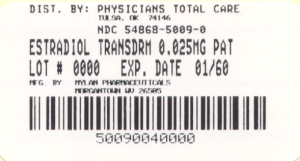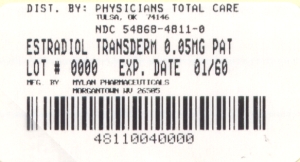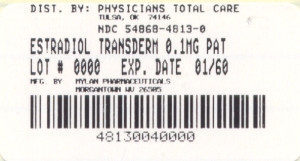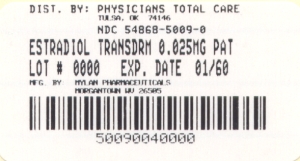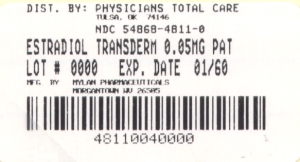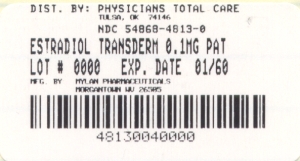Label: ESTRADIOL patch
-
Contains inactivated NDC Code(s)
NDC Code(s): 54868-4811-0, 54868-4813-0, 54868-5009-0 - Packager: Physicians Total Care, Inc.
- This is a repackaged label.
- Source NDC Code(s): 0378-3349, 0378-3350, 0378-3360
- Category: HUMAN PRESCRIPTION DRUG LABEL
- DEA Schedule: None
- Marketing Status: Abbreviated New Drug Application
Drug Label Information
Updated January 18, 2010
If you are a consumer or patient please visit this version.
- Download DRUG LABEL INFO: PDF XML
- Official Label (Printer Friendly)
- SPL UNCLASSIFIED SECTION
-
BOXED WARNING
(What is this?)
ESTROGENS INCREASE THE RISK OF ENDOMETRIAL CANCER
Close clinical surveillance of all women taking estrogens is important. Adequate diagnostic measures, including endometrial sampling when indicated, should be undertaken to rule out malignancy in all cases of undiagnosed persistent or recurring abnormal vaginal bleeding.
There is no evidence that the use of “natural” estrogens results in a different endometrial risk profile than synthetic estrogens of equivalent estrogen doses. (See WARNINGS, Malignant neoplasms, Endometrial cancer.)
CARDIOVASCULAR AND OTHER RISKS
Estrogens with and without progestins should not be used for the prevention of cardiovascular disease or dementia. (See WARNINGS, Cardiovascular disorders and Dementia.)
The Women’s Health Initiative (WHI) study reported increased risks of myocardial infarction, stroke, invasive breast cancer, pulmonary emboli, and deep vein thrombosis in postmenopausal women (50 to 79 years of age) during 5 years of treatment with oral conjugated estrogens (CE 0.625 mg) combined with medroxyprogesterone acetate (MPA 2.5 mg) relative to placebo. (See CLINICAL PHARMACOLOGY, Clinical Studies and WARNINGS, Cardiovascular disorders and Malignant neoplasms, Breast cancer.)
The Women’s Health Initiative Memory Study (WHIMS), a substudy of WHI, reported increased risk of developing probable dementia in postmenopausal women 65 years of age or older during 4 years of treatment with oral conjugated estrogens plus medroxyprogesterone acetate relative to placebo. It is unknown whether this finding applies to younger postmenopausal women. (See CLINICAL PHARMACOLOGY, Clinical Studies and WARNINGS, Dementia and PRECAUTIONS, Geriatric Use.)
Other doses of oral conjugated estrogens with medroxyprogesterone acetate, and other combinations and dosage forms of estrogens and progestins were not studied in the WHI clinical trials and, in the absence of comparable data, these risks should be assumed to be similar. Because of these risks, estrogens with or without progestins should be prescribed at the lowest effective doses and for the shortest duration consistent with treatment goals and risks for the individual woman.
-
DESCRIPTION
Estradiol Transdermal System Continuous Delivery (Once-Weekly) is designed to release estradiol continuously upon application to intact skin. Six (7.75 cm2, 11.625 cm2, 15.5 cm2, 18.6 cm2, 23.25 cm2 and 31 cm2) systems are available to provide nominal in vivo delivery of 0.025 mg, 0.0375 mg, 0.05 mg, 0.06 mg, 0.075 mg or 0.1 mg respectively of estradiol per day. The period of use is 7 days. Each system has a contact surface area of either 7.75 cm2, 11.625 cm2, 15.5 cm2, 18.6 cm2, 23.25 cm2 or 31 cm2, and contains 0.97 mg, 1.46 mg, 1.94 mg, 2.33 mg, 2.91 mg or 3.88 mg of estradiol USP respectively. The composition of the systems per unit area is identical. Estradiol USP is a white, crystalline powder, chemically described as estra-1,3,5(10)-triene-3,17ß-diol. It has a molecular formula of C18H2402 and molecular weight of 272.39. The structural formula is:
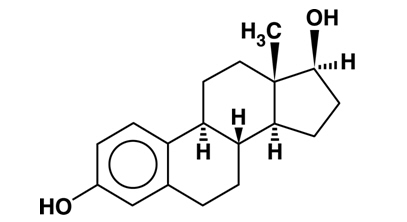
The Estradiol Transdermal System Continuous Delivery (Once-Weekly) comprises four layers. Proceeding from the visible surface toward the surface attached to the skin, these layers are (1) a foam backing with adhesive layer, (2) a polyester film, and (3) an acrylate adhesive matrix containing estradiol USP. A protective liner (4) of siliconized polyester film is attached to the adhesive surface and must be removed before the system can be used.

The active component of the system is estradiol. The remaining components of the system (propylene glycol, povidone, anhydrous colloidal silicon dioxide, pressure sensitive acrylic adhesive, copolymer foam, polyester film, and brown ink) are pharmacologically inactive.
-
CLINICAL PHARMACOLOGY
Endogenous estrogens are largely responsible for the development and maintenance of the female reproductive system and secondary sexual characteristics. Although circulating estrogens exist in a dynamic equilibrium of metabolic interconversions, estradiol is the principal intracellular human estrogen and is substantially more potent than its metabolites, estrone and estriol at the receptor level.
The primary source of estrogen in normally cycling adult women is the ovarian follicle, which secretes 70 mcg to 500 mcg of estradiol daily, depending on the phase of the menstrual cycle. After menopause, most endogenous estrogen is produced by conversion of androstenedione, secreted by the adrenal cortex, to estrone by peripheral tissues. Thus, estrone and the sulfate conjugated form, estrone sulfate, are the most abundant circulating estrogens in postmenopausal women.
Estrogens act through binding to nuclear receptors in estrogen-responsive tissues. To date, two estrogen receptors have been identified. These vary in proportion from tissue to tissue.
Circulating estrogens modulate the pituitary secretion of the gonadotropins luteinizing hormone (LH) and follicle-stimulating hormone (FSH), through a negative feedback mechanism. Estrogens act to reduce the elevated levels of these hormones seen in postmenopausal women.
PharmacokineticsTransdermal administration of Estradiol Transdermal System Continuous Delivery (Once-Weekly) produces mean serum concentrations of estradiol comparable to those produced by premenopausal women in the early follicular phase of the ovulatory cycle. The pharmacokinetics of estradiol following application of the Estradiol Transdermal System Continuous Delivery (Once-Weekly) were investigated in 197 healthy postmenopausal women in six studies. In five of the studies Estradiol Transdermal System Continuous Delivery (Once-Weekly) was applied to the abdomen and in a sixth study application to the buttocks and abdomen were compared.
AbsorptionThe Estradiol Transdermal System Continuous Delivery (Once-Weekly) continuously releases estradiol which is transported across intact skin leading to sustained circulating levels of estradiol during a 7 day treatment period. The systemic availability of estradiol after transdermal administration is about 20 times higher than that after oral administration. This difference is due to the absence of first-pass metabolism when estradiol is given by the transdermal route.
In a bioavailability study, the Estradiol Transdermal System Continuous Delivery (Once-Weekly) 7.75 cm2 was studied with the Estradiol Transdermal System Continuous Delivery (Once-Weekly) 15.5 cm2 as reference. The mean estradiol levels in serum from the two sizes are shown in Figure 1.

Figure 1 Mean Serum 17ß-Estradiol Concentrations vs. Time Profile following Application of a 7.75 cm2 Transdermal Patch and Application of a 15.5 cm2 Estradiol Transdermal System Continuous Delivery (Once-Weekly) Patch
Dose proportionality was demonstrated for the Estradiol Transdermal System Continuous Delivery (Once-Weekly) 7.75 cm2 transdermal system as compared to the Estradiol Transdermal System Continuous Delivery (Once-Weekly) 15.5 cm2 transdermal system in a 2 week crossover study with a 1 week washout period between the two transdermal systems in 24 postmenopausal women.
Dose proportionality was also demonstrated for the Estradiol Transdermal System Continuous Delivery (Once-Weekly) (15.5 cm2 and 31 cm2) in a 1 week study conducted in 54 postmenopausal women. The mean steady-state levels (Cavg) of the estradiol during the application of Estradiol Transdermal System Continuous Delivery (Once-Weekly) 31 cm2 and 15.5 cm2 on the abdomen were about 80 pg/mL and 40 pg/mL, respectively.
In a 3 week multiple application study in 24 postmenopausal women, the 31 cm2 Estradiol Transdermal System Continuous Delivery (Once-Weekly) produced average peak estradiol concentrations (Cmax) of approximately 100 pg/mL. Trough values at the end of each wear interval (Cmin) were approximately 35 pg/mL. Nearly identical serum curves were seen each week, indicating little or no accumulation of estradiol in the body. Serum estrone peak and trough levels were 60 pg/mL and 40 pg/mL, respectively.
In a single-dose, randomized, crossover study conducted to compare the effect of site of application, 38 postmenopausal women wore a single Estradiol Transdermal System Continuous Delivery (Once-Weekly) 31 cm2 system for one week on the abdomen and buttocks. The estradiol serum concentration profiles are shown in Figure 2. Cmax and Cavg values were, respectively, 25% and 17% higher with the buttock application than with the abdomen application.
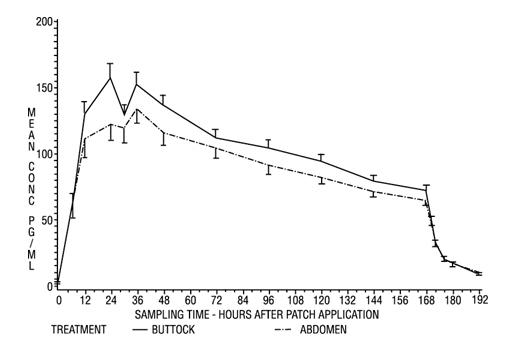
Figure 2 Observed Mean (± S.E.) Estradiol Serum Concentrations for a One Week Application of the Estradiol Transdermal System Continuous Delivery (Once-Weekly) (31 cm2) to the abdomen and buttocks of 38 postmenopausal women
-
SPL UNCLASSIFIED SECTION
Table 1 provides a summary of estradiol pharmacokinetic parameters determined during evaluation of Estradiol Transdermal System Continuous Delivery (Once-Weekly).
Table 1 Pharmacokinetic Summary (Mean Estradiol Values) Estradiol
Delivery
RateSurface
Area (cm2 )Application
SiteNo. of
SubjectsDosing Cmax
(pg/mL)Cmin
(pg/mL)Cavg
(pg/mL)0.025 7.75 Abdomen 24 Single 32 17 22 0.05 15.5 Abdomen 102 Single 71 29 41 0.1 31 Abdomen 139 Single 147 60 87 0.1 31 Buttock 38 Single 174 71 106 The relative standard deviation of each pharmacokinetic parameter after application to the abdomen averaged 50%, which is indicative of the considerable intersubject variability associated with transdermal drug delivery. The relative standard deviation of each pharmacokinetic parameter after application to the buttock was lower than that after application to the abdomen (e.g., for Cmax 39% vs. 62%, and for Cavg 35% vs. 48%).
DistributionThe distribution of exogenous estrogens is similar to that of endogenous estrogens.
Estrogens are widely distributed in the body and are generally found in higher concentrations in the sex hormone target organs. Estrogens circulate in the blood largely bound to sex hormone binding globulin (SHBG) and albumin.
MetabolismExogenous estrogens are metabolized in the same manner as endogenous estrogens. Circulating estrogens exist in a dynamic equilibrium of metabolic interconversions. These transformations take place mainly in the liver. Estradiol is converted reversibly to estrone, and both can be converted to estriol, which is the major urinary metabolite. Estrogens also undergo enterohepatic recirculation via sulfate and glucuronide conjugation in the liver, biliary secretion of conjugates into the intestine, and hydrolysis in the gut followed by reabsorption. In postmenopausal women, a significant proportion of the circulating estrogens exist as sulfate conjugates, especially estrone sulfate, which serves as a circulating reservoir for the formation of more active estrogens.
ExcretionEstradiol, estrone and estriol are excreted in the urine along with glucuronide and sulfate conjugates.
Special PopulationsGeriatricThere have not been sufficient numbers of geriatric patients involved in clinical studies utilizing Estradiol Transdermal System Continuous Delivery (Once-Weekly) to determine whether those over 65 years of age differ from younger subjects in their response to Estradiol Transdermal System Continuous Delivery (Once-Weekly).
PediatricNo pharmacokinetic study for Estradiol Transdermal System Continuous Delivery (Once-Weekly) has been conducted in a pediatric population.
GenderEstradiol Transdermal System Continuous Delivery (Once-Weekly) is indicated for use in women only.
RaceNo studies were done to determine the effect of race on the pharmacokinetics of Estradiol Transdermal System Continuous Delivery (Once-Weekly).
Patients with Renal ImpairmentTotal estradiol serum levels are higher in postmenopausal women with end stage renal disease (ESRD) receiving maintenance hemodialysis than in normal subjects at baseline and following oral doses of estradiol. Therefore, conventional transdermal estradiol doses used in individuals with normal renal function may be excessive for postmenopausal women with ESRD receiving maintenance hemodialysis.
Patients with Hepatic ImpairmentEstrogens may be poorly metabolized in patients with impaired liver function and should be administered with caution.
Drug InteractionsIn vitro and in vivo studies have shown that estrogens are metabolized partially by cytochrome P450 3A4 (CYP3A4). Therefore, inducers or inhibitors of CYP3A4 may affect estrogen drug metabolism. Inducers of CYP3A4 such as St. John’s Wort preparations (Hypericum perforatum), phenobarbital, carbamazepine, and rifampin may reduce plasma concentrations of estrogens, possibly resulting in a decrease in therapeutic effects and/or changes in the uterine bleeding profile. Inhibitors of CYP3A4 such as erythromycin, clarithromycin, ketoconazole, itraconazole, ritonavir and grapefruit juice may increase plasma concentrations of estrogens and may result in side effects.
AdhesionAn open-label study of adhesion potentials of placebo transdermal systems that correspond to the 7.75 cm2 and 15.5 cm2 sizes of Estradiol Transdermal System Continuous Delivery (Once-Weekly) was conducted in 112 healthy women of 45 to 75 years of age. Each woman applied both transdermal systems weekly, on the upper outer abdomen, for 3 consecutive weeks. It should be noted that lower abdomen and upper quadrant of the buttock are the approved sites of application for Estradiol Transdermal System Continuous Delivery (Once-Weekly).
The adhesion assessment was done visually on Days 2, 4, 5, 6, 7 of each week of transdermal system wear. A total of 1,654 adhesion observations were conducted for 333 transdermal systems of each size.
Of these observations, approximately 90% showed essentially no lift for both the 7.75 cm2 and 15.5 cm2 transdermal systems. Of the total number of transdermal systems applied, approximately 5% showed complete detachment for each size. Adhesion potentials of the 23.25 cm2 and 31 cm2 sizes of transdermal systems (0.075 mg/day and 0.1 mg/day) have not been studied.
Clinical StudiesEffects on vasomotor symptomsA study of 214 women 25 to 74 years old met the qualification criteria and were randomly assigned to one of the three treatment groups: 72 to the 0.05 mg estradiol patch, 70 to the 0.1 mg estradiol patch, and 72 to placebo. Potential subjects were postmenopausal women in good general health who experienced vasomotor symptoms. Natural menopause patients had not menstruated for at least 12 months and surgical menopause patients had undergone bilateral oophorectomy at least 4 weeks before evaluation for study entry. In order to enter the 11 week treatment phase of the study, potential subjects must have experienced a minimum of five moderate to severe hot flushes per week, or a minimum of 15 hot flushes of any severity per week, for 2 consecutive weeks. Women wore the patches in a cyclical fashion (three weeks on and one week off).
During treatment, all subjects used diaries to record the number and severity of hot flushes. Subjects were monitored by clinic visits at the end of weeks 1, 3, 7, and 11 and by telephone at the end of weeks 4, 5, 8, and 9.
Adequate data for the analysis of efficacy was available from 191 subjects. The results are presented as the mean ± SD number of flushes in each of the 3 treatment weeks of each 4 week cycle. In the 0.05 mg estradiol group, the mean weekly hot flush rate across all treatment cycles decreased from 46 ± 6.5 at baseline to 20 ± 3.0 (-67.0%). The 0.1 mg estradiol group had a decline in the mean weekly hot flush rate from 52 ± 4.4 at baseline to 16 ± 2.4 (-72.0%). In the placebo group, the mean weekly hot flush rate declined from 53 ± 4.5 at baseline to 46 ± 6.5 (-18.1%). Compared with placebo, the 0.05 mg and 0.1 mg estradiol groups showed a statistically significantly larger mean decrease in hot flushes across all treatment cycles (P less than 0.05). When the response to treatment was analyzed for each of the three cycles of therapy, similar statistically significant differences were observed between both estradiol treatment groups and the placebo group during all treatment cycles.
In a double-blind, placebo-controlled, randomized study of 187 women receiving Estradiol Transdermal System Continuous Delivery (Once-Weekly) 0.025 mg/day or placebo continuously for up to three 28 day cycles, the Estradiol Transdermal System Continuous Delivery (Once-Weekly) 0.025 mg/day dosage was shown to be statistically better than placebo at weeks 4 and 12 for relief of both the frequency and severity of moderate to severe vasomotor symptoms.
Table 2 Mean Change from Baseline in the Number of Moderate to Severe Vasomotor Symptoms (ITT) Treatment Group Statistics Week 4 Week 8 Week 12 E2 TDS N 82 84 68 Mean -6.45 -7.69 -7.56 SD 4.65 4.76 4.64 Placebo N 83 71 65 Mean -5.11 -5.98 -5.98 SD 7.43 8.63 9.69 p-Value Less than 0.002 Less than 0.003 A second active-control trial of 193 randomized subjects was supportive of the placebo-controlled trial.
Effects on bone mineral densityA two year clinical trial enrolled a total of 175 healthy, hysterectomized, postmenopausal, non-osteoporotic (i.e., lumbar spine bone mineral density less than 0.9 gm/cm2) women at 10 study centers in the United States. One hundred twenty nine subjects were allocated to receive active treatment with four different doses of estradiol patches (7.75 cm2, 15.5 cm2, 23.25 cm2, 31 cm2) and 46 subjects were allocated to receive placebo patches. Seventy seven percent of the randomized subjects (100 on active drug and 34 on placebo) contributed data to the analysis of percent change of A-P spine bone mineral density (BMD), the primary efficacy variable (see Figure 3). A statistically significant overall treatment effect at each timepoint was noted, implying bone preservation for all active treatment groups at all timepoints, as opposed to bone loss for placebo at all timepoints.
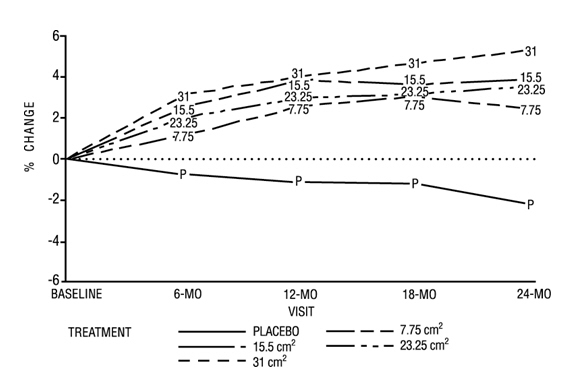
Figure 3 Mean Percent Change from Baseline in Lumbar Spine (A-P View) Bone Mineral Density by Treatment and Time Last Observation Carried Forward
Percent change in BMD of the total hip (see Figure 4), was also statistically significantly different from placebo for all active treatment groups. The results of the measurements of biochemical markers supported the finding of efficacy for all doses of transdermal estradiol. Serum osteocalcin levels decreased, indicative of a decrease in bone formation, at all timepoints for all active treatment doses, statistically significantly different from placebo (which generally rose). Urinary deoxypyridinoline and pyridinoline changes also suggested a decrease in bone turnover for all active treatment groups.
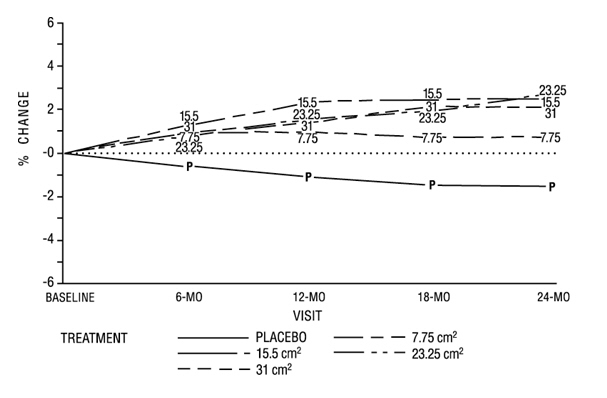
Figure 4 Mean Percent Change from Baseline in Total Hip by Treatment and Time Last Observation Carried Forward
Footnote: This figure is based on 74% of the randomized subjects (95 on active drug and 34 on placebo).
-
SPL UNCLASSIFIED SECTION
Women's Health Initiative Studies
The Women’s Health Initiative (WHI) enrolled a total of 27,000 predominantly healthy postmenopausal women to assess the risks and benefits of either the use of oral 0.625 mg conjugated estrogens (CE) per day alone or the use of 0.625 mg conjugated estrogens plus 2.5 mg medroxyprogesterone acetate (MPA) per day compared to placebo in the prevention of certain chronic diseases. The primary endpoint was the incidence of coronary heart disease (CHD) (nonfatal myocardial infarction and CHD death), with invasive breast cancer as the primary adverse outcome studied. A “global index” included the earliest occurrence of CHD, invasive breast cancer, stroke, pulmonary embolism (PE), endometrial cancer, colorectal cancer, hip fracture, or death due to other cause. The study did not evaluate the effects of CE or CE/MPA on menopausal symptoms.
The CE/MPA substudy was stopped early because, according to the predefined stopping rule, the increased risk of breast cancer and cardiovascular events exceeded the specified benefits included in the “global index.” Results of the CE/MPA substudy, which included 16,608 women (average age of 63 years, range 50 to 79; 83.9% White, 6.5% Black, 5.5% Hispanic), after an average follow-up of 5.2 years are presented in Table 3 below:
Table 3 RELATIVE AND ABSOLUTE RISK SEEN IN THE CE/MPA SUBSTUDY OF WHI (*) Event
Relative Risk
CE/MPA vs. Placebo
at 5.2 Years
(95% CI (*,1)
Placebo
N=8102
Absolute Risk per
CE/MPA
N=8506
10,000 Person-years
CHD events
Nonfatal MI
CHD death
1.29 (1.02-1.63)
1.32 (1.02-1.72)
1.18 (0.70-1.97)
30
23
6
37
30
7
Invasive breast cancer (2)
1.26 (1.00-1.59)
30
38
Stroke
1.41 (1.07-1.85)
21
29
Pulmonary embolism
2.13 (1.39-3.25)
8
16
Colorectal cancer
0.63 (0.43-0.92)
16
10
Endometrial cancer
0.83 (0.47-1.47)
6
5
Hip fracture
0.66 (0.45-0.98)
15
10
Death due to cause others than the events above
0.92 (0.74-1.14)
40
37
Global Index (3)
1.15 (1.03-1.28)
151
170
Deep vein thrombosis (4)
2.07 (1.49-2.87)
13
26
Vertebral fractures (4)
0.66 (0.44-0.98)
15
9
Other osteoporotic fractures (4)
0.77 (0.69-0.86)
170
131
(*) adapted from JAMA, 2002; 288:321-333
(1) * nominal confidence intervals unadjusted from multiple looks and multiple comparisons
(2) includes metastatic and non-metastatic breast cancer with the exceptioin of in situ breast cancer
(3) a subset of the events was combined in a "global index", defined as the earliest occurrence of CHD events,
invasive breast cancer, stroke, pulmonary embolism, endometrial cancer, colorectal cancer, hip fracture,
or death due to other causes
(4) not included in Global Index
For those outcomes included in the “global index,” absolute excess risks per 10,000 women-years in the group treated with CE/MPA were 7 more CHD events, 8 more strokes, 8 more PEs, and 8 more invasive breast cancers, while absolute risk reductions per l0,000 women-years were 6 fewer colorectal cancers and 5 fewer hip fractures. The absolute excess risk of events included in the “global index” was 19 per 10,000 women-years. There was no difference between the groups in terms of all-cause mortality. (See BOXED WARNINGS , WARNINGS, and PRECAUTIONS.)
Women's Health Initiative Memory StudyThe Women’s Health Initiative Memory Study (WHIMS), a substudy of WHI, enrolled 4,532 predominantly postmenopausal women 65 years of age and older (47% were age 65 to 69 years, 35% were 70 to 74 years, and 18% were 75 years of age and older) to evaluate the effects of CE/MPA (0.625 mg conjugated estrogens plus 2.5 mg medroxyprogesterone acetate) on the incidence of probable dementia (primary outcome) compared with placebo. After an average follow-up of 4 years, 40 women in the estrogen/progestin group (45 per 10,000 women-years) and 21 in the placebo group (22 per 10,000 women-years) were diagnosed with probable dementia. The relative risk of probable dementia in the hormone therapy group was 2.05 (95% CI, 1.21 to 3.48) compared to placebo. Differences between groups became apparent in the first year of treatment. It is unknown whether these findings apply to younger postmenopausal women. (See BOXED WARNINGS and WARNINGS, Dementia and PRECAUTIONS, Geriatric Use.)
-
INDICATIONS AND USAGE
Estradiol Transdermal System Continuous Delivery (Once-Weekly), USP is indicated in the:
- Treatment of moderate to severe vasomotor symptoms associated with the menopause.
- Treatment of moderate to severe symptoms of vulvar and vaginal atrophy associated with the menopause. When prescribing solely for the treatment of symptoms of vulvar and vaginal atrophy, topical vaginal products should be considered.
- Treatment of hypoestrogenism due to hypogonadism, castration or primary ovarian failure.
- Prevention of postmenopausal osteoporosis. When prescribing solely for the
prevention of postmenopausal osteoporosis, therapy should only be considered for
women at significant risk of osteoporosis and non-estrogen medications should be
carefully considered.
The mainstays for decreasing the risk of postmenopausal osteoporosis are weight bearing exercise, adequate calcium and vitamin D intake, and when indicated, pharmacologic therapy. Postmenopausal women require an average of 1500 mg/day of elemental calcium. Therefore, when not contraindicated, calcium supplementation may be helpful for women with suboptimal dietary intake. Vitamin D supplementation of 400 IU/day to 800 IU/day may also be required to ensure adequate daily intake in postmenopausal women.
-
CONTRAINDICATIONS
Estradiol Transdermal System Continuous Delivery (Once-Weekly) should not be used in women with any of the following conditions:
- Undiagnosed abnormal genital bleeding.
- Known, suspected, or history of cancer of the breast.
- Known or suspected estrogen-dependent neoplasia.
- Active deep vein thrombosis, pulmonary embolism or a history of these conditions.
- Active or recent (e.g., within the past year) arterial thromboembolic disease (e.g., stroke, myocardial infarction).
- Liver dysfunction or disease.
- Estradiol Transdermal System Continuous Delivery (Once-Weekly) should not be used in patients with known hypersensitivity to its ingredients.
- Known or suspected pregnancy. There is no indication for Estradiol Transdermal System Continuous Delivery (Once-Weekly) in pregnancy. There appears to be little or no increased risk of birth defects in children born to women who have used estrogens and progestins from oral contraceptives inadvertently during early pregnancy (see PRECAUTIONS).
-
WARNINGS
See BOXED WARNINGS.
Cardiovascular disordersEstrogen and estrogen/progestin therapy has been associated with an increased risk of cardiovascular events such as myocardial infarction and stroke, as well as venous thrombosis and pulmonary embolism (venous thromboembolism or VTE). Should any of these occur or be suspected, estrogens should be discontinued immediately.
Risk factors for arterial vascular disease (e.g., hypertension, diabetes mellitus, tobacco use, hypercholesterolemia, and obesity) and/or venous thromboembolism (e.g., personal history or family history of VTE, obesity, and systemic lupus erythematosus) should be managed appropriately.
Coronary heart disease and strokeIn the Women’s Health Initiative (WHI) study, an increased risk of stroke was observed in women receiving oral CE compared to placebo.
In the CE/MPA substudy of WHI an increased risk of coronary heart disease (CHD) events (defined as nonfatal myocardial infarction and CHD death) was observed in women receiving CE/MPA compared to women receiving placebo (37 vs. 30 per 10,000 women-years). The increase in risk was observed in year one and persisted. (See CLINICAL PHARMACOLOGY, Clinical Studies.)
In the same substudy of WHI, an increased risk of stroke was observed in women receiving CE/MPA compared to women receiving placebo (29 vs. 21 per 10,000 women-years). The increase in risk was observed after the first year and persisted.
In postmenopausal women with documented heart disease (n = 2,763, average age 66.7 years) a controlled clinical trial of secondary prevention of cardiovascular disease (Heart and Estrogen/Progestin Replacement Study; HERS) treatment with CE/MPA (0.625 mg/2.5 mg per day) demonstrated no cardiovascular benefit. During an average follow-up of 4.1 years, treatment with CE/MPA did not reduce the overall rate of CHD events in postmenopausal women with established coronary heart disease. There were more CHD events in the CE/MPA-treated group than in the placebo group in year 1, but not during the subsequent years. Two thousand three hundred and twenty one women from the original HERS trial agreed to participate in an open-label extension of HERS, HERS II. Average follow-up in HERS II was an additional 2.7 years, for a total of 6.8 years overall. Rates of CHD events were comparable among women in the CE/MPA group and the placebo group in HERS, HERS II, and overall.
Venous thromboembolism (VTE)In the Women’s Health Initiative (WHI) study, an increased risk of deep vein thrombosis was observed in women receiving CE compared to placebo.
In the CE/MPA substudy of WHI, a 2-fold greater rate of VTE, including deep venous thrombosis and pulmonary embolism, was observed in women receiving CE/MPA compared to women receiving placebo. The rate of VTE was 34 per 10,000 women-years in the CE/MPA group compared to 16 per 10,000 women-years in the placebo group. The increase in VTE risk was observed during the first year and persisted. (See CLINICAL PHARMACOLOGY, Clinical Studies.)
If feasible, estrogens should be discontinued at least 4 to 6 weeks before surgery of the type associated with an increased risk of thromboembolism, or during periods of prolonged immobilization.
Malignant neoplasmsEndometrial cancerThe use of unopposed estrogens in women with intact uteri has been associated with an increased risk of endometrial cancer. The reported endometrial cancer risk among unopposed estrogen users is about 2-fold to 12-fold greater than in non-users, and appears dependent on duration of treatment and on estrogen dose. Most studies show no significant increased risk associated with use of estrogens for less than one year. The greatest risk appears associated with prolonged use, with increased risks of 15-fold to 24-fold for 5 to 10 years or more and this risk has been shown to persist for at least 8 to 15 years after estrogen therapy is discontinued.
Clinical surveillance of all women taking estrogen/progestin combinations is important. Adequate diagnostic measures, including endometrial sampling when indicated, should be undertaken to rule out malignancy in all cases of undiagnosed persistent or recurring abnormal vaginal bleeding. There is no evidence that the use of natural estrogens results in a different endometrial risk profile than synthetic estrogens of equivalent estrogen dose. Adding a progestin to estrogen therapy has been shown to reduce the risk of endometrial hyperplasia, which may be a precursor to endometrial cancer.
Breast cancerThe use of estrogens and progestins by postmenopausal women has been reported to increase the risk of breast cancer. The most important randomized clinical trial providing information about this issue is the Women’s Health Initiative (WHI) substudy of CE/MPA (see CLINICAL PHARMACOLOGY, Clinical Studies). The results from observational studies are generally consistent with those of the WHI clinical trial and report no significant variation in the risk of breast cancer among different estrogens or progestins, doses, or routes of administration.
The CE/MPA substudy of WHI reported an increased risk of breast cancer in women who took CE/MPA for a mean follow-up of 5.6 years. Observational studies have also reported an increased risk for estrogen/progestin combination therapy, and a smaller increased risk for estrogen alone therapy, after several years of use. In the WHI trial and from observational studies, the excess risk increased with duration of use. From observational studies, the risk appeared to return to baseline in about 5 years after stopping treatment. In addition, observational studies suggest that the risk of breast cancer was greater, and became apparent earlier, with estrogen/progestin combination therapy as compared to estrogen alone therapy.
In the CE/MPA substudy, 26% of the women reported prior use of estrogen alone and/or estrogen/progestin combination hormone therapy. After a mean follow-up of 5.6 years during the clinical trial, the overall relative risk of invasive breast cancer was 1.24 (95% confidence interval 1.01 - 1.54), and the overall absolute risk was 41 vs. 33 cases per 10,000 women-years, for CE/MPA compared with placebo. Among women who reported prior use of hormone therapy, the relative risk of invasive breast cancer was 1.86, and the absolute risk was 46 vs. 25 cases per 10,000 women-years, for CE/MPA compared with placebo. Among women who reported no prior use of hormone therapy, the relative risk of invasive breast cancer was 1.09, and the absolute risk was 40 vs. 36 cases per 10,000 women-years for CE/MPA compared with placebo. In the same substudy, invasive breast cancers were larger and diagnosed at a more advanced stage in the CE/MPA group compared with the placebo group. Metastatic disease was rare with no apparent difference between the two groups. Other prognostic factors such as histologic subtype, grade and hormone receptor status did not differ between the groups.
The use of estrogen plus progestin has been reported to result in an increase in abnormal mammograms requiring further evaluation. All women should receive yearly breast examinations by a healthcare provider and perform monthly breast self-examinations. In addition, mammography examinations should be scheduled based on patient age, risk factors, and prior mammogram results.
DementiaIn the Women’s Health Initiative Memory Study (WHIMS), 4,532 generally healthy postmenopausal women 65 years of age and older were studied, of whom 35% were 70 to 74 years of age and 18% were 75 or older. After an average follow-up of 4 years, 40 women being treated with CE/MPA (1.8%, n = 2,229) and 21 women in the placebo group (0.9%, n = 2,303) received diagnoses of probable dementia. The relative risk for CE/MPA versus placebo was 2.05 (95% confidence interval 1.21 - 3.48), and was similar for women with and without histories of menopausal hormone use before WHIMS. The absolute risk of probable dementia for CE/MPA versus placebo was 45 versus 22 cases per 10,000 women-years, and the absolute excess risk for CE/MPA was 23 cases per 10,000 women-years. It is unknown whether these findings apply to younger postmenopausal women. (See CLINICAL PHARMACOLOGY, Clinical Studies and PRECAUTIONS, Geriatric Use.)
Gallbladder diseaseA 2-fold to 4-fold increase in the risk of gallbladder disease requiring surgery in postmenopausal women receiving estrogens has been reported.
HypercalcemiaEstrogen administration may lead to severe hypercalcemia in patients with breast cancer and bone metastases. If hypercalcemia occurs, use of the drug should be stopped and appropriate measures taken to reduce the serum calcium level.
Visual abnormalitiesRetinal vascular thrombosis has been reported in patients receiving estrogens. Discontinue medication pending examination if there is sudden partial or complete loss of vision, or a sudden onset of proptosis, diplopia, or migraine. If examination reveals papilledema or retinal vascular lesions, estrogens should be permanently discontinued.
-
PRECAUTIONS
GeneralAddition of a progestin when a woman has not had a hysterectomy
Studies of the addition of a progestin for 10 or more days of a cycle of estrogen administration, or daily with estrogen in a continuous regimen, have reported a lowered incidence of endometrial hyperplasia than would be induced by estrogen treatment alone. Endometrial hyperplasia may be a precursor to endometrial cancer.
There are, however, possible risks that may be associated with the use of progestins with estrogens compared to estrogen-alone treatment. These include a possible increased risk of breast cancer.
Elevated blood pressureIn a small number of case reports, substantial increases in blood pressure have been attributed to idiosyncratic reactions to estrogens. In a large, randomized, placebo-controlled clinical trial, a generalized effect of estrogens on blood pressure was not seen. Blood pressure should be monitored at regular intervals with estrogen use.
HypertriglyceridemiaIn patients with preexisting hypertriglyceridemia, estrogen therapy may be associated with elevations of plasma triglycerides leading to pancreatitis and other complications.
Impaired liver function and past history of cholestatic jaundiceEstrogens may be poorly metabolized in patients with impaired liver function. For patients with a history of cholestatic jaundice associated with past estrogen use or with pregnancy, caution should be exercised and in the case of recurrence, medication should be discontinued.
HypothyroidismEstrogen administration leads to increased thyroid-binding globulin (TBG) levels. Patients with normal thyroid function can compensate for the increased TBG by making more thyroid hormone, thus maintaining free T4 and T3 serum concentrations in the normal range. Patients dependent on thyroid hormone replacement therapy who are also receiving estrogens may require increased doses of their thyroid replacement therapy. These patients should have their thyroid function monitored in order to maintain their free thyroid hormone levels in an acceptable range.
Fluid retentionBecause estrogens may cause some degree of fluid retention, patients with conditions that might be influenced by this factor, such as a cardiac or renal dysfunction, warrant careful observation when estrogens are prescribed.
HypocalcemiaEstrogens should be used with caution in individuals with severe hypocalcemia.
Ovarian cancerThe CE/MPA substudy of WHI reported that estrogen plus progestin increased the risk of ovarian cancer. After an average follow-up of 5.6 years, the relative risk for ovarian cancer for CE/MPA versus placebo was 1.58 (95% confidence interval 0.77-3.24) but was not statistically significant. The absolute risk for CE/MPA versus placebo was 4.2 versus 2.7 cases per 10,000 women-years. In some epidemiological studies, the use of estrogen alone, in particular for ten or more years, has been associated with an increased risk of ovarian cancer. Other epidemiologic studies have not found these associations.
Exacerbation of endometriosisEndometriosis may be exacerbated with administration of estrogens. A few cases of malignant transformation of residual endometrial implants have been reported in women treated post-hysterectomy with estrogen alone therapy. For patients known to have residual endometriosis post-hysterectomy, the addition of progestin should be considered.
Exacerbation of other conditionsEstrogens may cause an exacerbation of asthma, diabetes mellitus, epilepsy, migraine or porphyria, systemic lupus erythematosus, and hepatic hemangiomas and should be used with caution in women with these conditions.
Patient InformationPhysicians are advised to discuss the PATIENT INFORMATION leaflet with patients for whom they prescribe Estradiol Transdermal System Continuous Delivery (Once-Weekly).
Laboratory TestsEstrogen administration should be initiated at the lowest dose approved for the indication and then guided by clinical response rather than by serum hormone levels (e.g., estradiol, FSH).
Drug/Laboratory Test Interactions- Accelerated prothrombin time, partial thromboplastin time, and platelet aggregation time; increased platelet count; increased factors II, VII antigen, VIII antigen, VIII coagulant activity, IX, X, XII, VII-X complex, II-VII-X complex, and beta-thromboglobulin; decreased levels of antifactor Xa and antithrombin III, decreased antithrombin III activity; increased levels of fibrinogen and fibrinogen activity; increased plasminogen antigen and activity.
- Increased thyroid-binding globulin (TBG) levels leading to increased circulating total thyroid hormone levels as measured by protein bound iodine (PBI), T4 levels (by column or by radioimmunoassay) or T3 levels by radioimmunoassay. T3 resin uptake is decreased, reflecting the elevated TBG. Free T4 and free T3 concentrations are unaltered. Patients on thyroid replacement therapy may require higher doses of thyroid hormone.
- Other binding proteins may be elevated in serum (i.e., corticosteroid binding globulin (CBG), sex hormone-binding globulin (SHBG)) leading to increased total circulating corticosteroids and sex steroids, respectively. Free hormone concentrations may be decreased. Other plasma proteins may be increased (angiotensinogen/renin substrate, alpha-1-antitrypsin, ceruloplasmin).
- Increased plasma HDL and HDL2 cholesterol subfraction concentrations, reduced LDL cholesterol concentration, and in oral formulations increased triglyceride levels.
- Impaired glucose tolerance.
- Reduced response to metyrapone test.
Long-term continuous administration of estrogen, with and without progestin, in women with and without a uterus, has shown an increased risk of endometrial cancer, breast cancer, and ovarian cancer. (See BOXED WARNINGS, WARNINGS and PRECAUTIONS.)
Long-term continuous administration of natural and synthetic estrogens in certain animal species increases the frequency of carcinomas of the breast, uterus, cervix, vagina, testis, and liver.
PregnancyEstradiol Transdermal System Continuous Delivery (Once-Weekly) should not be used during pregnancy. (See CONTRAINDICATIONS.)
Nursing MothersEstrogen administration to nursing mothers has been shown to decrease the quantity and quality of the milk. Detectable amounts of estrogens have been identified in the milk of mothers receiving this drug. Caution should be exercised when Estradiol Transdermal System Continuous Delivery (Once-Weekly) is administered to a nursing woman.
Pediatric UseEstrogen replacement therapy has been used for the induction of puberty in adolescents with some forms of pubertal delay. Safety and effectiveness in pediatric patients have not otherwise been established. Large and repeated doses of estrogen over an extended time period have been shown to accelerate epiphyseal closure, which could result in short adult stature if treatment is initiated before the completion of physiologic puberty in normally developing children. If estrogen is administered to patients whose bone growth is not complete, periodic monitoring of bone maturation and effects on epiphyseal centers is recommended during estrogen administration. Estrogen treatment of prepubertal girls also induces premature breast development and vaginal cornification, and may induce vaginal bleeding. In boys, estrogen treatment may modify the normal pubertal process and induce gynecomastia. (See INDICATIONS AND USAGE and DOSAGE AND ADMINISTRATION.)
Geriatric UseThere have not been sufficient numbers of geriatric patients involved in clinical studies utilizing Estradiol Transdermal System Continuous Delivery (Once-Weekly) to determine whether those over 65 years of age differ from younger subjects in their response to Estradiol Transdermal System Continuous Delivery (Once-Weekly).
In the Women’s Health Initiative Memory Study, including 4,532 women 65 years of age and older, followed for an average of 4 years, 82% (n = 3,729) were 65 to 74 while 18% (n = 803) were 75 and over. Most women (80%) had no prior hormone therapy use. Women treated with conjugated estrogens plus medroxyprogesterone acetate were reported to have a 2-fold increase in the risk of developing probable dementia. Alzheimer’s disease was the most common classification of probable dementia in both the conjugated estrogens plus medroxyprogesterone acetate group and the placebo group. Ninety percent of the cases of probable dementia occurred in the 54% of women that were older than 70. (See BOXED WARNING and WARNINGS, Dementia.)
-
ADVERSE REACTIONS
See BOXED WARNINGS, WARNINGS and PRECAUTIONS.
Because clinical trials are conducted under widely varying conditions, adverse reaction rates observed in the clinical trials of a drug cannot be directly compared to rates in the clinical trials of another drug and may not reflect the rates observed in practice. The adverse reaction information from clinical trials does, however, provide a basis for identifying the adverse events that appear to be related to drug use and for approximating rates.
Summary of Most Frequently Reported Adverse Experiences/Medical Events (Greater Than or Equal To 5%) by Treatment Groups
Estradiol Transdermal System
Continuous Delivery (Once-Weekly)
AE per Body System 0.025 mg/day
(N=219)0.05 mg/day
(N=201)0.1 mg/day
(N=194)Placebo
(N=72)Body as a Whole 21%
39%
37%
29%
Headache
5%
18%
13%
10%
Pain
1%
8%
11%
7%
Back Pain
4%
8%
9%
6%
Edema
0.5%
13.%
10%
6%
Gastrointestinal 9%
21%
29%
18%
Abdominal Pain
0.0%
11%
16%
8%
Nausea
1%
5%
6%
3%
Flatulence
1%
3%
7%
1%
Musculoskeletal 7%
9%
11%
4%
Arthralgia
1%
5%
5%
3%
Psychiatric 13%
10%
11%
1%
Depression
1%
5%
8%
0%
Reproductive 12%
18%
41%
11%
Breast Pain
5%
8%
29%
4%
Leukorrhea
1%
6%
7%
1%
Respiratory 15%
26%
29%
14%
URTI
6%
17%
17%
8%
Pharyngitis
0.5%
3%
7%
3%
Sinusitis
4%
$5
5%
3%
Rhinitis
2%
4%
6%
1%
Skin and Appendages 19%
12%
12%
15%
Pruritus
0.5%
6%
3%
6%
Post-marketing ExperienceThe following adverse reactions have been identified during post approval use of Estradiol Transdermal System Continuous Delivery (Once-Weekly): a few cases in which there were a combination of the symptoms of generalized hives or rash with swelling of the throat or eyelid edema. Because these reactions are reported voluntarily from a population of uncertain size, it is not always possible to reliably estimate their frequency or establish a causal relationship to drug exposure.
The following additional adverse reactions have been reported with estrogen and/or progestin therapy.
Genitourinary systemChanges in vaginal bleeding pattern and abnormal withdrawal bleeding or flow; breakthrough bleeding; spotting; dysmenorrhea; increase in size of uterine leiomyomata; vaginitis, including vaginal candidiasis; change in amount of cervical secretion; changes in cervical ectropion; ovarian cancer; endometrial hyperplasia; endometrial cancer.
BreastsTenderness, enlargement, pain, nipple discharge, galactorrhea; fibrocystic breast changes; breast cancer.
CardiovascularDeep and superficial venous thrombosis; pulmonary embolism; thrombophlebitis; myocardial infarction; stroke; increase in blood pressure.
GastrointestinalNausea, vomiting; abdominal cramps, bloating; cholestatic jaundice; increased incidence of gallbladder disease; pancreatitis, enlargement of hepatic hemangiomas.
SkinChloasma or melasma, which may persist when drug is discontinued; erythema multiforme; erythema nodosum; hemorrhagic eruption; loss of scalp hair; hirsutism; pruritus, rash.
EyesRetinal vascular thrombosis, intolerance to contact lenses.
Central nervous systemHeadache; migraine; dizziness; mental depression; chorea; nervousness; mood disturbances; irritability; exacerbation of epilepsy, dementia.
MiscellaneousIncrease or decrease in weight; reduced carbohydrate tolerance; aggravation of porphyria; edema; arthalgias; leg cramps; changes in libido; anaphylactoid/anaphylactic reactions; hypocalcemia; exacerbation of asthma; increased triglycerides.
- OVERDOSAGE
-
DOSAGE AND ADMINISTRATION
When estrogen is prescribed for a postmenopausal woman with a uterus, progestin should also be initiated to reduce the risk of endometrial cancer. A woman without a uterus does not need progestin. Use of estrogen, alone or in combination with a progestin, should be with the lowest effective dose and for the shortest duration consistent with treatment goals and risks for the individual woman. Patients should be reevaluated periodically as clinically appropriate (e.g., 3 month to 6 month intervals) to determine if treatment is still necessary. (See BOXED WARNINGS and WARNINGS.) For women who have a uterus, adequate diagnostic measures, such as endometrial sampling, when indicated, should be undertaken to rule out malignancy in cases of undiagnosed persistent or recurring abnormal vaginal bleeding.
Patients should be started at the lowest dose. Six (7.75 cm2, 11.625 cm2, 15.5 cm2, 18.6 cm2, 23.25 cm2 and 31 cm2) Estradiol Transdermal Systems Continuous Delivery (Once-Weekly) are available. For the treatment of vasomotor symptoms, treatment should be initiated with the 7.75 cm2 (0.025 mg/day) Estradiol Transdermal System Continuous Delivery (Once-Weekly) applied to the skin once weekly. The dose should be adjusted as necessary to control symptoms. Clinical responses (relief of symptoms) at the lowest effective dose should be the guide for establishing administration of the Estradiol Transdermal System Continuous Delivery (Once-Weekly), especially in women with an intact uterus. Attempts to taper or discontinue the medication should be made at 3 month to 6 month intervals. In women who are not currently taking oral estrogens, treatment with Estradiol Transdermal System Continuous Delivery (Once-Weekly) can be initiated at once. In women who are currently taking oral estrogen, treatment with the Estradiol Transdermal System Continuous Delivery (Once-Weekly) can be initiated one week after withdrawal of oral therapy or sooner if symptoms reappear in less than one week. For the prevention of postmenopausal osteoporosis, the minimum dose that has been shown to be effective is the 7.75 cm2 (0.025 mg/day) Estradiol Transdermal System Continuous Delivery (Once-Weekly). Response to therapy can be assessed by biochemical markers and measurement of bone mineral density.
Application of the SystemThe adhesive side of the Estradiol Transdermal System Continuous Delivery (Once-Weekly) should be placed on a clean, dry area of the lower abdomen or the upper quadrant of the buttock. The Estradiol Transdermal System Continuous Delivery (Once-Weekly) should not be applied to or near the breasts. The sites of application must be rotated, with an interval of at least one week allowed between applications to a particular site. The area selected should not be oily, damaged, or irritated. The waistline should be avoided, since tight clothing may rub and remove the system. Application to areas where sitting would dislodge the system should also be avoided. The system should be applied immediately after opening the pouch and removing the protective liner. The system should be pressed firmly in place with the fingers for about 10 seconds, making sure there is good contact, especially around the edges. If the system lifts, apply pressure to maintain adhesion. In the event that a system should fall off, a new system should be applied for the remainder of the 7 day dosing interval. Only one system should be worn at any one time during the 7 day dosing interval. Swimming, bathing, or using a sauna while using the Estradiol Transdermal System Continuous Delivery (Once-Weekly) has not been studied, and these activities may decrease the adhesion of the system and the delivery of estradiol.
Removal of the SystemRemoval of the system should be done carefully and slowly to avoid irritation of the skin. Should any adhesive remain on the skin after removal of the system, allow the area to dry for 15 minutes. Then gently rubbing the area with an oil-based cream or lotion should remove the adhesive residue.
Used patches still contain some active hormones. Each patch should be carefully folded in half so that it sticks to itself before throwing it away.
-
HOW SUPPLIED
Estradiol Transdermal System, 0.025 mg/day Continuous Delivery (Once-Weekly), USP – each 7.75 cm2 system contains 0.97 mg of estradiol USP
NDC 54868-5009-0 Individual Carton of 4 systems
Estradiol Transdermal System, 0.05 mg/day Continuous Delivery (Once-Weekly), USP – each 15.5 cm2 system contains 1.94 mg of estradiol USP
NDC 54868-4811-0 Individual Carton of 4 systems
Estradiol Transdermal System, 0.1 mg/day Continuous Delivery (Once-Weekly), USP – each 31 cm2 system contains 3.88 mg of estradiol USP
NDC 54868-4813-0 Individual Carton of 4 systems
Store at 20° to 25°C (68° to 77°F). [See USP for Controlled Room Temperature.] Do not store unpouched. Apply immediately upon removal from the protective pouch.
MYLAN PHARMACEUTICALS INC.
Morgantown, WV 26505REVISED AUGUST 2008
ETS:R16 -
PATIENT PACKAGE INSERT
Estradiol Transdermal System
Continuous Delivery (Once-Weekly), USP
PATIENT INFORMATIONRead this PATIENT INFORMATION before you start using Estradiol Transdermal System Continuous Delivery (Once-Weekly), USP and read what you get each time you refill Estradiol Transdermal System Continuous Delivery (Once-Weekly), USP. There may be new information. This information does not take the place of talking to your healthcare provider about your medical condition or your treatment.
What is the most important information I should know about Estradiol Transdermal System Continuous Delivery (Once-Weekly) (an estrogen hormone)?
- Estrogens increase the chances of getting cancer of the uterus.
Report any unusual vaginal bleeding right away while you are taking estrogens. Vaginal bleeding after menopause may be a warning sign of cancer of the uterus (womb). Your healthcare provider should check any unusual vaginal bleeding to find out the cause.
- Do not use estrogens with or without progestins to prevent heart disease, heart attacks, strokes, or dementia.
Using estrogens with or without progestins may increase your chances of getting heart attack, strokes, breast cancer, and blood clots. Using estrogens with progestins may increase your risk of dementia. You and your healthcare provider should talk regularly about whether you still need treatment with Estradiol Transdermal System Continuous Delivery (Once-Weekly).
What is Estradiol Transdermal System Continuous Delivery (Once-Weekly)?
Estradiol Transdermal System Continuous Delivery (Once-Weekly) is a medicine that contains estrogen hormones.
What is Estradiol Transdermal System Continuous Delivery (Once-Weekly) used for?
Estradiol Transdermal System Continuous Delivery (Once-Weekly) is used after menopause to:
-
reduce moderate to severe hot flashes. Estrogens are
hormones made by a woman’s ovaries. The ovaries normally stop making estrogens
when a woman is between 45 to 55 years old. This drop in body estrogen levels
causes the “change of life” or menopause (the end of monthly menstrual periods).
Sometimes, both ovaries are removed during an operation before natural menopause
takes place. The sudden drop in estrogen levels causes “surgical menopause.”
When the estrogen levels begin dropping, some women develop very uncomfortable symptoms, such as feelings of warmth in the face, neck, and chest, or sudden strong feelings of heat and sweating (“hot flashes” or “hot flushes”). In some women, the symptoms are mild, and they will not need estrogens. In other women, symptoms can be more severe. You and your healthcare provider should talk regularly about whether you still need treatment with Estradiol Transdermal System Continuous Delivery (Once-Weekly).
- treat moderate to severe dryness, itching, and burning in or around the vagina. You and your healthcare provider should talk regularly about whether you still need treatment with Estradiol Transdermal System Continuous Delivery (Once-Weekly) to control these problems. If you use Estradiol Transdermal System Continuous Delivery (Once-Weekly) only to treat your dryness, itching, and burning in and around your vagina, talk with your healthcare provider about whether a topical vaginal product would be better for you.
- treat certain conditions in which a young woman’s ovaries do not produce enough estrogen naturally.
-
help reduce your chances of getting osteoporosis (thin weak
bones). Osteoporosis from menopause is a thinning of the bones that makes
them weaker and easier to break. If you use Estradiol Transdermal System
Continuous Delivery (Once-Weekly) only to prevent osteoporosis from menopause,
talk with your healthcare provider about whether a different treatment or
medicine without estrogens might be better for you. You and your healthcare
provider should talk regularly about whether you should continue with Estradiol
Transdermal System Continuous Delivery (Once-Weekly).
Weight bearing exercise, like walking or running, and taking calcium and vitamin D supplements may also lower your chances of getting postmenopausal osteoporosis. It is important to talk about exercise and supplements with your healthcare provider before starting them.
Who should not use Estradiol Transdermal System Continuous Delivery (Once-Weekly)?
Do not start using Estradiol Transdermal System Continuous Delivery (Once-Weekly) if you:
- have unusual vaginal bleeding.
- currently have or have had certain cancers. Estrogens may increase the chances of getting certain types of cancers, including cancer of the breast or uterus. If you have or had cancer, talk with your healthcare provider about whether you should take Estradiol Transdermal System Continuous Delivery (Once-Weekly).
- had a stroke or heart attack in the past year.
- currently have or have had blood clots.
- currently have or have had liver problems.
- are allergic to Estradiol Transdermal System Continuous Delivery (Once-Weekly) or any of its ingredients. See section titled “What are the ingredients in Estradiol Transdermal System Continuous Delivery (Once-Weekly)” at the end of this leaflet for a list of ingredients in Estradiol Transdermal System Continuous Delivery (Once-Weekly).
- think you may be pregnant.
Tell your healthcare provider:
- if you are breast-feeding. The hormone in Estradiol Transdermal System Continuous Delivery (Once-Weekly) can pass into your milk.
- about all of your medical problems. Your healthcare provider may need to check you more carefully if you have certain conditions, such as asthma (wheezing), epilepsy (seizures), migraine, endometriosis, lupus, problems with your heart, liver, thyroid, kidneys, or have high calcium levels in your blood.
- about all the medicines you take. This includes prescription and nonprescription medicines, vitamins, and herbal supplements. Some medicines may affect how Estradiol Transdermal System Continuous Delivery (Once-Weekly) works. Estradiol Transdermal System Continuous Delivery (Once-Weekly) may also affect how your other medicines work.
- if you are going to have surgery or will be on bed rest. You may need to stop taking estrogens.
How should I use Estradiol Transdermal System Continuous Delivery (Once-Weekly)?
Estradiol Transdermal System Continuous Delivery (Once-Weekly) is a patch that you wear on your skin. The estrogen in the Estradiol Transdermal System Continuous Delivery (Once-Weekly) passes through your skin. You must change your Estradiol Transdermal System Continuous Delivery (Once-Weekly) patch every 7 days (once a week). See the end of this leaflet for complete instructions on how to use Estradiol Transdermal System Continuous Delivery (Once-Weekly).
- Start at the lowest dose and talk to your healthcare provider about how well that dose is working for you.
- Estrogens should be used at the lowest dose possible for your treatment only as long as needed. You and your healthcare provider should talk regularly (for example, every 3 months to 6 months) about the dose you are taking and whether you still need treatment with Estradiol Transdermal System Continuous Delivery (Once-Weekly).
What are the possible side effects of estrogens?
Less common but serious side effects include:
- Breast cancer
- Cancer of the uterus
- Stroke
- Heart attack
- Blood clots
- Dementia
- Gallbladder disease
- Ovarian cancer
These are some of the warning signs of serious side effects:
- Breast lumps
- Unusual vaginal bleeding
- Dizziness and faintness
- Changes in speech
- Severe headaches
- Chest pain
- Shortness of breath
- Pains in your legs
- Changes in vision
- Vomiting
Call your healthcare provider right away if you get any of these warning signs, or any other unusual symptom that concerns you.
Common side effects include:
- Headache
- Breast pain
- Irregular vaginal bleeding or spotting
- Stomach/abdominal cramps, bloating
- Nausea and vomiting
- Hair loss
Other side effects include:
- High blood pressure
- Liver problems
- High blood sugar
- Fluid retention
- Enlargement of benign tumors of the uterus (“fibroids”)
- Vaginal yeast infection
These are not all the possible side effects of Estradiol Transdermal System Continuous Delivery (Once-Weekly). For more information, ask your healthcare provider or pharmacist.
What can I do to lower my chances of a serious side effect with Estradiol Transdermal System Continuous Delivery (Once-Weekly)?
Talk with your healthcare provider regularly about whether you should continue using Estradiol Transdermal System Continuous Delivery (Once-Weekly).
- If you have a uterus, talk to your healthcare provider about whether the addition of a progestin is right for you.
- See your healthcare provider right away if you get vaginal bleeding while using Estradiol Transdermal System Continuous Delivery (Once-Weekly).
- Have a breast exam and mammogram (breast X-ray) every year unless your healthcare provider tells you something else. If members of your family have had breast cancer or if you have ever had breast lumps or an abnormal mammogram, you may need to have breast exams more often.
- If you have high blood pressure, high cholesterol (fat in the blood), diabetes, are overweight, or if you use tobacco, you may have higher chances for getting heart disease. Ask your healthcare provider for ways to lower your chances for getting heart disease.
General information about safe and effective use of Estradiol Transdermal System Continuous Delivery (Once-Weekly)
Medicines are sometimes prescribed for conditions that are not mentioned in patient information leaflets. Do not take Estradiol Transdermal System Continuous Delivery (Once-Weekly) for conditions for which it was not prescribed. Do not give Estradiol Transdermal System Continuous Delivery (Once-Weekly) to other people, even if they have the same symptoms you have. It may harm them.
Keep Estradiol Transdermal System Continuous Delivery (Once-Weekly) out of the reach of children.
This leaflet provides a summary of the most important information about Estradiol Transdermal System Continuous Delivery (Once-Weekly). If you would like more information, talk with your healthcare provider or pharmacist. You can ask for information about Estradiol Transdermal System Continuous Delivery (Once-Weekly) that is written for health professionals. You can get more information by calling the toll free number 1-877-446-3679 (1-877-4-INFO-RX).
What are the ingredients in Estradiol Transdermal System Continuous Delivery (Once-Weekly)?
The active ingredient of Estradiol Transdermal System Continuous Delivery (Once-Weekly) is estradiol. Estradiol Transdermal System Continuous Delivery (Once-Weekly) also contains propylene glycol, povidone, anhydrous colloidal silicon dioxide, pressure sensitive acrylic adhesive, copolymer foam, polyester film, and brown ink (yellow iron oxide pigment, red iron oxide pigment and carbon black pigment).
Instructions for Use
How and Where to Apply the Estradiol Transdermal System Continuous Delivery (Once-Weekly) Patch
Each Estradiol Transdermal System Continuous Delivery (Once-Weekly) patch is individually sealed in a protective pouch. To open the pouch, hold it with the Estradiol Transdermal System Continuous Delivery (Once-Weekly) name facing you. Tear from top to bottom using the right side tear notch. Tear from left to right using the top tear notch. Pull the pouch open. The Estradiol Transdermal System Continuous Delivery (Once-Weekly) patch is the peach colored foam round disk attached to the clear protective release liner.
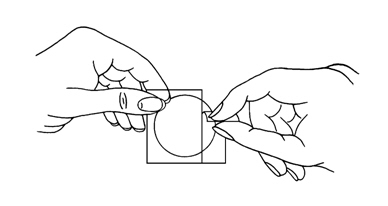
Apply the sticky side of the Estradiol Transdermal System Continuous Delivery (Once-Weekly) patch to a clean, dry area of the lower stomach below your belly button or the top of the buttocks (see diagram below). Do not apply the Estradiol Transdermal System Continuous Delivery (Once-Weekly) patch to your breasts. The sites of application on the lower stomach and buttocks must be rotated, allowing at least one week between applications to the same site. The site selected should not be oily, damaged, or irritated. Avoid the waistline, since tight clothing may rub and remove the patch. Also, do not put the patch on areas where sitting would rub it off or loosen it. Apply the patch right after opening the pouch and removing the protective liner. Press the patch firmly in place with your fingers for about 10 seconds. Make sure that it sticks all over, especially around the edges.
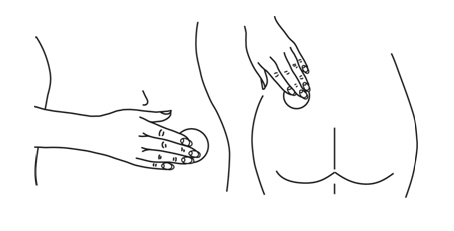
The Estradiol Transdermal System Continuous Delivery (Once-Weekly) patch should be worn continuously for one week. You may wish to try different sites when putting on a new patch, to find ones that are most comfortable for you and where clothing will not rub on the patch or loosen it.
When to Apply the Estradiol Transdermal System Continuous Delivery (Once-Weekly)?
The Estradiol Transdermal System Continuous Delivery (Once-Weekly) patch should be changed once weekly. Remove the used patch. Carefully fold it in half so that it sticks to itself because used patches still contain active hormones and discard it. Any adhesive that might remain on your skin can be easily rubbed off. Then place the new Estradiol Transdermal System Continuous Delivery (Once-Weekly) patch on a different skin site. (The same skin site should not be used again for at least one week after removal of the patch.)
Contact with water when you are bathing, swimming, or showering may affect the patch. If the patch falls off, the same patch may be reapplied to another area of the lower abdomen. Make sure that there is good contact, especially around the edges. If the patch will not stick completely to your skin, put a new patch on a different area of the lower abdomen. Do not apply two patches at the same time.
Estrogens should be used only as long as needed. You and your healthcare provider should talk regularly (for example, every 3 months to 6 months) about whether you still need treatment with Estradiol Transdermal System Continuous Delivery (Once-Weekly).
Call your doctor for medical advice about side effects. You may report side effects to FDA at 1-800-FDA-1088.
MYLAN PHARMACEUTICALS INC.
Morgantown, WV 26505REVISED AUGUST 2008
PL:ETS:R11 - PRINCIPAL DISPLAY PANEL
-
INGREDIENTS AND APPEARANCE
ESTRADIOL
estradiol patchProduct Information Product Type HUMAN PRESCRIPTION DRUG Item Code (Source) NDC:54868-4811(NDC:0378-3349) Route of Administration TRANSDERMAL Active Ingredient/Active Moiety Ingredient Name Basis of Strength Strength ESTRADIOL (UNII: 4TI98Z838E) (ESTRADIOL - UNII:4TI98Z838E) ESTRADIOL 0.97 mg in 48 [USP'U] Inactive Ingredients Ingredient Name Strength PROPYLENE GLYCOL (UNII: 6DC9Q167V3) POVIDONE (UNII: FZ989GH94E) SILICON DIOXIDE (UNII: ETJ7Z6XBU4) Packaging # Item Code Package Description Marketing Start Date Marketing End Date 1 NDC:54868-4811-0 4 in 1 CARTON 1 1 in 1 POUCH 1 24 [USP'U] in 1 PATCH Marketing Information Marketing Category Application Number or Monograph Citation Marketing Start Date Marketing End Date ANDA ANDA075182 06/14/2003 ESTRADIOL
estradiol patchProduct Information Product Type HUMAN PRESCRIPTION DRUG Item Code (Source) NDC:54868-4813(NDC:0378-3360) Route of Administration TRANSDERMAL Active Ingredient/Active Moiety Ingredient Name Basis of Strength Strength ESTRADIOL (UNII: 4TI98Z838E) (ESTRADIOL - UNII:4TI98Z838E) ESTRADIOL 1.46 mg in 48 [USP'U] Inactive Ingredients Ingredient Name Strength PROPYLENE GLYCOL (UNII: 6DC9Q167V3) POVIDONE (UNII: FZ989GH94E) SILICON DIOXIDE (UNII: ETJ7Z6XBU4) Packaging # Item Code Package Description Marketing Start Date Marketing End Date 1 NDC:54868-4813-0 4 in 1 CARTON 1 1 in 1 POUCH 1 24 [USP'U] in 1 PATCH Marketing Information Marketing Category Application Number or Monograph Citation Marketing Start Date Marketing End Date ANDA ANDA075182 06/09/2003 ESTRADIOL
estradiol patchProduct Information Product Type HUMAN PRESCRIPTION DRUG Item Code (Source) NDC:54868-5009(NDC:0378-3350) Route of Administration TRANSDERMAL Active Ingredient/Active Moiety Ingredient Name Basis of Strength Strength ESTRADIOL (UNII: 4TI98Z838E) (ESTRADIOL - UNII:4TI98Z838E) ESTRADIOL 1.94 mg in 48 [USP'U] Inactive Ingredients Ingredient Name Strength PROPYLENE GLYCOL (UNII: 6DC9Q167V3) POVIDONE (UNII: FZ989GH94E) SILICON DIOXIDE (UNII: ETJ7Z6XBU4) Packaging # Item Code Package Description Marketing Start Date Marketing End Date 1 NDC:54868-5009-0 4 in 1 CARTON 1 1 in 1 POUCH 1 24 [USP'U] in 1 PATCH Marketing Information Marketing Category Application Number or Monograph Citation Marketing Start Date Marketing End Date ANDA ANDA075182 12/11/2008 Labeler - Physicians Total Care, Inc. (194123980) Establishment Name Address ID/FEI Business Operations Physicians Total Care, Inc. 194123980 relabel

